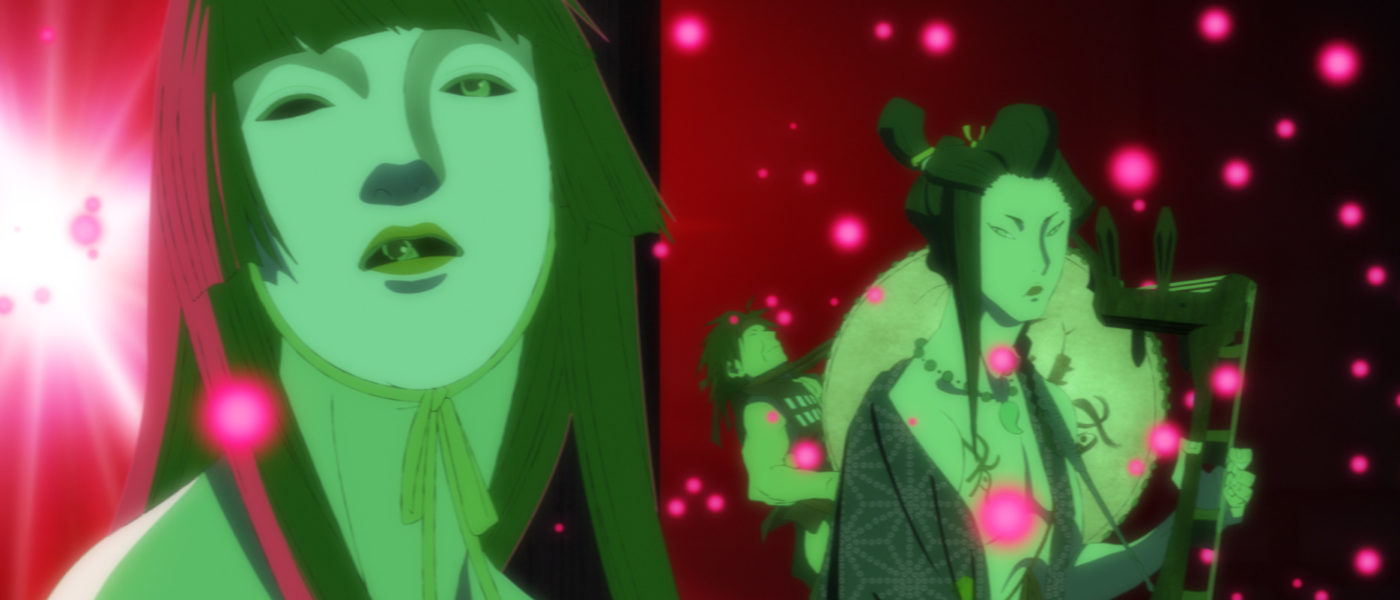Masaaki Yuasa Rocks the Muromachi
DIRECTED BY: MASAAKI YUASA/2021
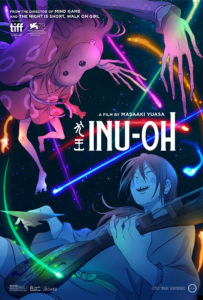
Masaaki Yuasa is the most compelling director working in mainstream anime today. Coming from a distinct background as an animator, primarily working on animation for young children like Chibi Maruko-chan, Doraemon, and – most prominently – Shin-chan, before taking the world of animation by storm in 2004 with his gorgeously frenetic, visually eclectic feature debut, Mind Game. Since then, the director has helmed a variety of visually and narratively distinct works in the form of short films, television series, and – of course – more features. While his work following 2017’s The Night is Short, Walk on Girl has erred towards the more mainstream, albeit with a generous helping of Yuasa’s idiosyncratic directorial touch, it has been some time since Yuasa created something as wild and wonderful as his earliest directorial work.
Inu-Oh breaks this trend. With a US release handled by Gkids, this feature helmed by Yuasa and primarily animated at Science SARU is the director’s first foray into the realm of jidaigeki. A period drama set in the 14th century Muromachi period, Yuasa employs a carefully blended balance of spiritualism, history, levity, and violence to tell the story of two young men. One a noh dancer deformed before their birth by a curse, the other a biwa player blinded as a child by a cursed sword, as the pair give voice to the unheard ghosts of Heike samurai, in the form fabulous performances featuring gorgeously animated, visually arresting sequences of dance combined with a fabulous, anachronistic soundtrack combining traditional Japanese instruments like the biwa and shamisen with 70s fuzz guitar and keyboard.
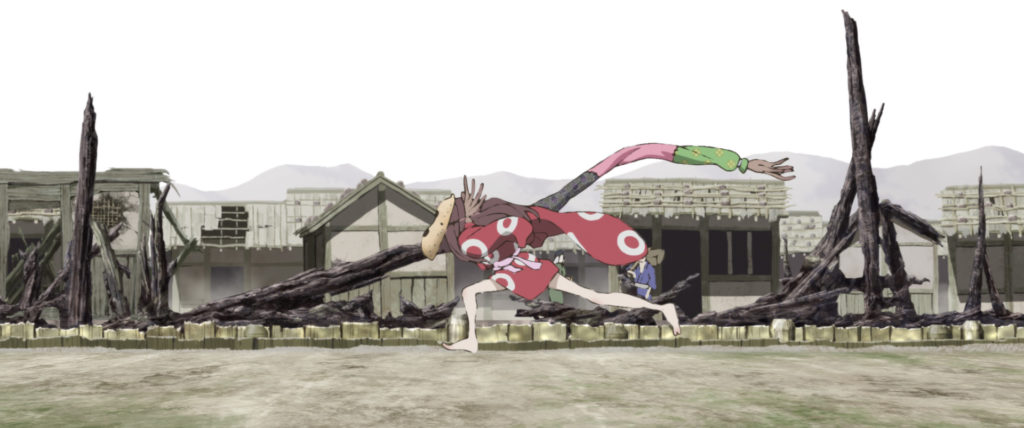
The deformed dancer is the title character, Inu-Oh, who we first see as he is being born. Cursed and rendered a social pariah by a deal his father – the head of troupe of noh performers – makes with a demon, he covers his face with a gourd and lives in isolation, only taking pleasure in acts of mischief and in dancing to the music of his father’s troupe, listening in from a distance. His life changes dramatically upon the arrival of Tomona, a fisherman’s son left blind and without a father after an incident recovering a cursed sword for the shogun Ashikaga Yoshimitsu, now a wandering minstrel of the Todo-za that tells the Tale of Heike. Upon meeting, the pair realize that the mystical origin of their disfigurement seems to allow them see the restless spirits of the Heike clan samurai that wander the city, and the two set about creating new songs, expanding the Tale of Heike.
Their first performance, telling the story of the Lord Tadanori and the arms cut from men clinging to fleeing boats, is an elaborate spectacle, attracting a huge crowd of enthralled onlookers. At its finale, a part of Inu-Oh’s curse is lifted, revealing that these performances may be the key to freeing him of his monstrous affliction. The pair of minstrels continue to perform their additions to the Tale of Heike, only growing in popularity further. Invited to perform for the shogun, the pair prepare for their biggest performance. But, with the shogun looking to consolidate his power and Inu-Oh’s father furious at being upstaged by his son, the pair’s biggest performance may be their last.
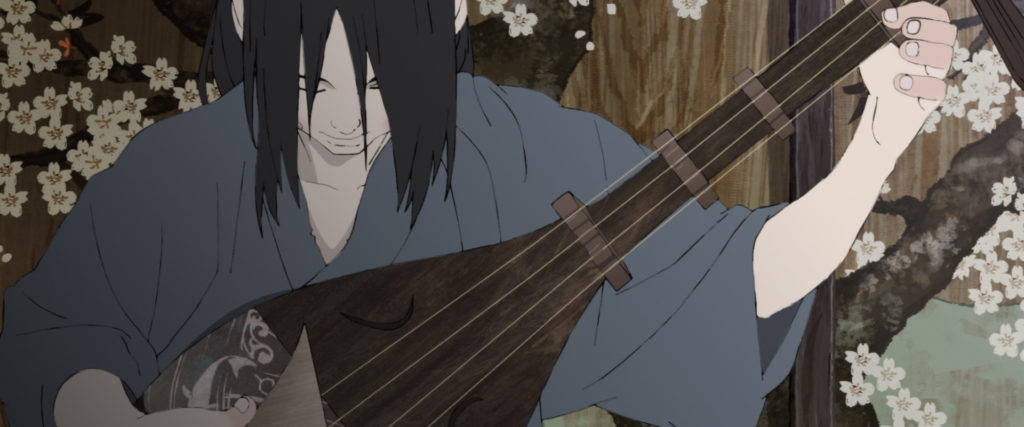
The narrative is immediately compelling, establishing a largely grounded world with occasional bursts of graphic violence and casual integration of the spiritual and fantastical in a fashion that invites comparison to Princess Mononoke, but without feeling derivative in the slightest. There is extreme violence; severed spines, people bisected, and one instance of a man exploding in spectacular fashion, but it’s framed by the layouts, timing, and others’ reactions in a way that doesn’t linger, simply treating these explosive moments frankly. The sense of joy in the performances and interplay between Inu-Oh and Tomona elevates the work, nicely contrasting the violence and the more grounded depiction of a corrupt, uncaring feudal society in a way that resonates, pulling through somewhat uneven pacing to result in a truly mesmerizing work.
Concepts of transformation, class structure, and the relationship between art and power structures take the fore, but never distract. Both Inu-Oh and Tomona are fluid figures, transformed initially by tragedy imposed upon them, but later actively shifting their identities through their art. Inu-Oh is transformed literally, shedding his curse in a fashion not dissimilar to Osamu Tezuka’s Dororo, while Tomona’s shifts are represented by the variety of new titles over the course of the film. The pair of outsiders seek to push the boundaries of art and societal norms, but are constricted by an upper class that pursues the maintenance of a strict social hierarchy and which is more than willing to pursue violence against those that disrupt it. While Inu-Oh does manage to end on a positive note, its elements of tragedy and a finale that mirrors that of Belladonna of Sadness adds a poignancy to the mostly light narrative, putting a fine point on the lofty ambitions of art and the unfair, often cruel nature of those at the top of class-oriented societies.
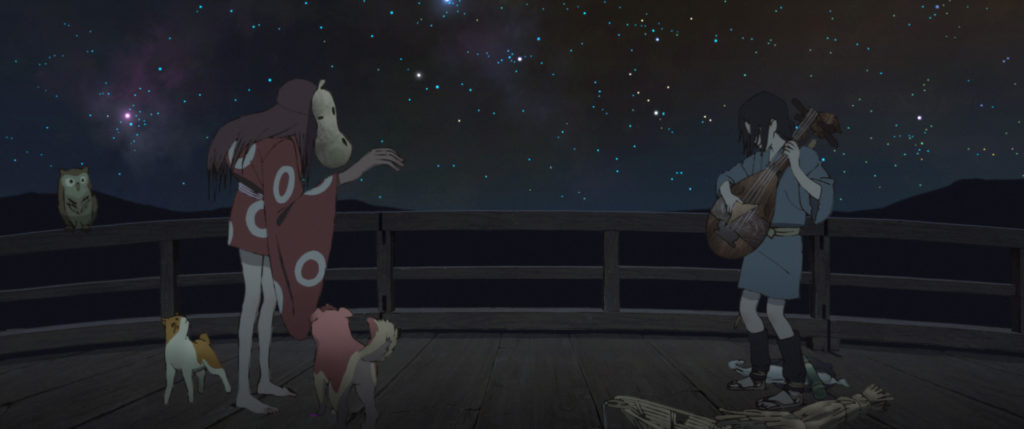
But Inu-Oh’s larger thematic and narrative strengths are only a fraction of its appeal. The visual design, use of gradients and textures, painterly touches, varying line quality, and marvelously eclectic character designs coalesce into a singular style that perfectly pairs with its writing. The juxtaposition between its largely muted palette and flashes of color in the sequences centering the performances and paranormal creates an effective imbalance that highlights both in a satisfying way. Character design especially, with a wide variety of body shapes and special detail paid to traditionally unattractive quirks like misaligned teeth and the folding of skin from particular angles, serves to juxtapose the wild and loose performances of its lower-class, physically disabled protagonists against the reserved, restricted members of the shogun’s court and those it favors, reframing those quirks and conventionally unappealing elements in a more positive light.
Animation is another highlight, as to be expected from a work directed by Yuasa and the animation team at Science SARU, helmed by Chief Animation Directors Satoshi Nakano and Yoshimichi Kameda. The aforementioned varying line quality, in conjunction with rougher lineart that retains some stray lines and and looser painting, hearkens back to the wild and beautiful animation of the 70s with that came about with the advent of heat-transfer, freeing animators’ from the need for inkers. The performance sequences are the obvious highlights, lots of wild character acting incorporating subtler movements in multi-layered, excellently choreographed scenes that still retain a great deal of weight. That sense of momentum especially, and the contrast drawn between Inu-Oh and Tomona’s movements, is wonderful. Even in smaller movements we see great care taken to subtleties, particularly with facial movements, but with an overall restraint and economy that heightens the moments of full animation.
One would be remiss to discuss Inu-Oh without bringing up its soundtrack. Much like the rest of the film, it’s centered around juxtaposition and a sense of contrast, though more pointedly in its use of electric guitar and keyboard. But even this is handled in an interesting, nostalgic fashion, with composer Yoshihide Otomo eschewing a modern pop sound for a very 70s prog rock style, hearkening back to The Helpful Soul’s music for A Thousand & One Nights or Masahiko Satoh’s music for the aforementioned Belladonna of Sadness. Its implementation of biwa, shamisen, and taiko helps bridge the gap while still the anachronism remains immediately recognizable, separating Inu-Oh and Tomona from their contemporaries while still making the soundtrack feel like the product of a bygone time.
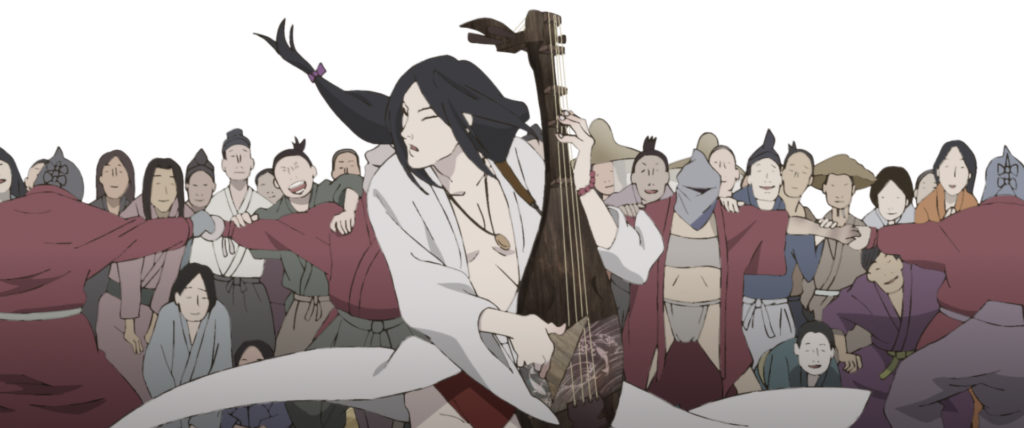
As a whole, Inu-Oh is a delightful, gorgeous, and even poignant spectacle of animation. Far more measured and maybe not so quite magical as his frenetic debut feature, but still retaining a looseness and sense of artistic ingenuity that seeps into all his work, all wrapped in a narrative the seems to actively buck trends and seeks to do more than put a unique spin on previously trodden ground. Its opening may perhaps be a bit disorienting for those unfamiliar with Japanese history, but as it goes on one will find an incredibly accessible, masterfully crafted story of artists, class, oppression, friendship, and rock ‘n roll.


